This was published 4 years ago
Venice Biennale confronts the art of politics
By Andrew Bock
When the architect of the Australian pavilion at the Venice Biennale dropped by Richard Bell’s Aboriginal tent embassy in a nearby park, people thought there might have been tension.
Bell had wrapped a large model of John Denton’s award-winning, $6 million pavilion in chains, craned it onto a barge, and motored it up and down along the Biennale’s Giardini foreshore in protest at the white bias of art-world hierarchies – or "white art in black boxes", as Bell put it.
But Denton loved the humour and congratulated Bell. Some believe all art is political but Bell, whose work was short-listed for the Australian pavilion, notes that "political art only makes up 4 per cent of the market. I see that as an opportunity."
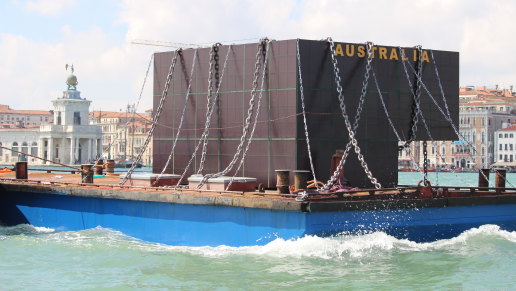
In Richard Bell's disruption, a model of the Australian pavilion at the Venice Biennale is chained on a barge. Credit: Caroline Gardam
It was always paradoxical for the Venice Biennale – an exhibition founded in 1895 to present the art of nations – to adopt the quasi-political theme in May You Live in Interesting Times. Northern Irish artist Cathy Wilkes almost rejected her invitation to represent Britain because of her dislike of countries and borders. Few chosen artists have created work about the politics of art, but the variety of ways in which they have reimagined the art of politics is inspiring.
Christoph Buchel has placed Barca Nostra, the mangled hull of a ship in which 700 refugees drowned off Sicily in 2015, on the wharf outside a cafe – to protests from at least one other artist who said, "That’s not art – it’s media, it’s death, it shouldn’t be here."
Australian pavilion artist Angelica Mesiti’s multi-channel video work Assembly features a subtle, slow occupation of a political forum by musical translations, dissonance and shimmering harmonies.
Most of the works by the 79 artists in the Biennale's curated exhibition, and in the 90 international pavilions, are political, even when they take an ironic approach to global issues. One of the best is by China's Sun Yuan and Peng Yu: their giant, hydraulic, robotic, limbed paintbrush, Can’t Help Myself, housed in a clear acrylic cage, spins threateningly and bends down to sweep up dark crimson liquid - oil, paint or blood - which keeps spreading across the floor. Every few minutes the robotic brush pauses for a celebratory dance, proud of what it has achieved. It's a comical yet ominous depiction of the technology that claims to save us from disasters.
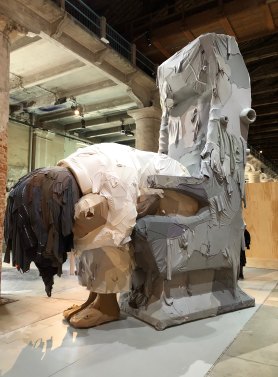
Yin Xiuzhen's six-metre high, hollow Trojan is covered with used cotton shirts.Credit: Andrew Bock
There are several haunting memorials, not to fallen soldiers, princes or queens, but to the citizens, poets, journalists, women and children "disappeared" by dictatorships. Discordo Ergo Sum (I protest therefore I am) by Renate Bertlmann, in the Austrian pavilion, features glass roses skewered on rows of metal spikes, neatly fusing the flowers of anti-war protests with a First World War cemetery.
On similar rows of metal spikes Indian artist Shilpa Gupta has skewered the words of 100 poets imprisoned or killed since the 7th century. In your tongue, I cannot fit, a work coming to Hobart's Dark Mofo next month, features microphones suspended above the spikes that broadcast their words about prison, intermittently forming a chorus of urgent whispers, hauntingly bringing the poets' ghosts to life.
Some works are too overtly judgmental, approaching propaganda or essay, albeit for a good cause. Arthur Jafa's film The White Album, which won the Best Participant prize, begins with a wonderfully challenging collation of found footage of people being racist, criticising racists or occupying threatening racial archetypes (a Muslim with an automatic rifle, for example). But the voiceover descends into slogan and polemic.
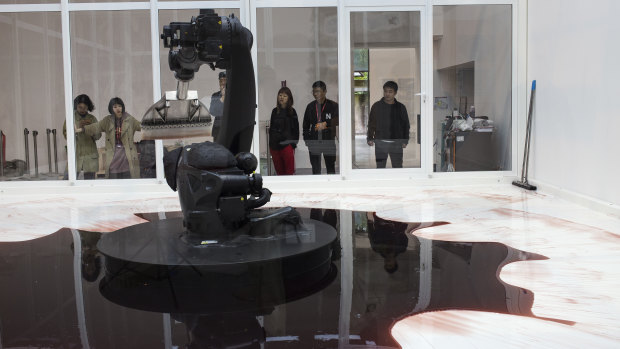
Robots to the rescue? Sun Yuan and Peng Yu's Can't Help Myself.Credit: Venice Biennale
The value of this biennale’s survey of political art is best demonstrated when two artists address the same subject or trope - an aeroplane, for example.
Polish pavilion artist Roman Stanczak’s Flight turns a luxury jet inside out, its wiring and engine organs on the outside in a succinct inversion of the winged symbol of western progress, imploded now by terrorism and the tangled futures of technology and wealth.
In the main exhibition, Yin Xiuzhen’s Trojan lets viewers walk inside a six-metre tall sculpture of a passenger in crash position, head praying between her knees.
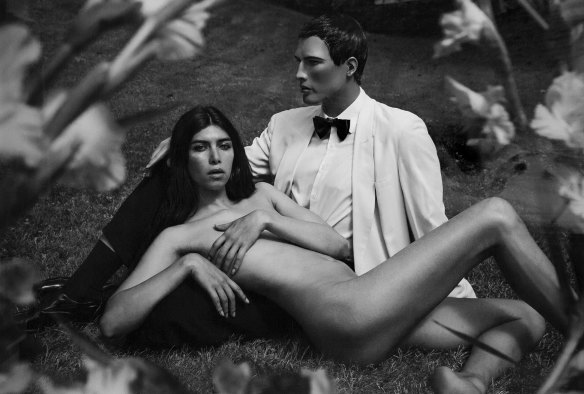
Martine Gutierrez's self-portrait, Body En Thrall.Credit: Venice Biennale
For the first time in the Biennale’s 123-year history, the main exhibition features as many female artists as male (and a few non-gendered). Several women photographers have produced powerful self-portraits that challenge the viewer’s gaze, in a genre popularised by Frida Kahlo.
For Body En Thrall, New York artist Martine Gutierrez posed naked in the arms of a male dummy bridegroom, her expression both acquiescent and defiant. South African artist Zanele Muholi portrays herself as a defiant black queen wearing accessories that refer to bondage. And Japanese artist Mari Katayama made disturbing and beautiful self-portraits by adorning her amputated and prosthetic limbs with doll-making materials.
There are few works requiring words, signalling that the conceptual modern era is giving way to more kinetic or accessible engagements with media.
US artist Christian Marclay, whose 24-hour epic The Clock recently showed in Melbourne, is showing 48 War Movies: a nauseating tiling of 48 complete films about the horrors of war. BLKNWS by filmmaker Kahlil Joseph (of Beyonce Lemonade fame) is a two-channel music video that samples black political figures and footage of persecution and survival along with high and pop art, sublimely edited to match the different rhythms of the soundtrack.
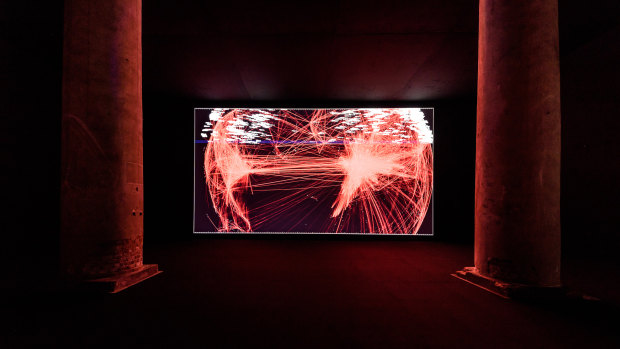
Against the grain: Ryoji Ikeda's data-verse.Credit: Venice Biennale
There is a parallel growth in the number and sophistication of collaborations - works made by teams of accomplished artists and artisans, with a principal artist as director and curator as producer - led by an impressive collection of video works. Many works also more seamlessly combine genres of art such as music, theatre, poetry, puppetry or dance.
Lithuania won the Golden Lion for best national pavilion for its opera Sun & Sea (Marina), set on a rectangular beach and observed from above as if it were a painting, with the performers dramatising climate change.
Perhaps ironically, it's almost a political act to depict positive visions of the future at this Biennale. The latest work by Japanese screen artist Ryoji Ikeda, data-verse, is a dangerously beautiful vision of a universe depicted by movements of data. Ikeda’s monumental mathematical and musical composition contrasts with the tenderly crafted mathematics of underwater organisms explored in the work of Australians Christine and Margaret Wertheim.
In a Collateral event outside the Biennale grounds, South Australian artists James Darling and Lesley Forwood have created a 30-metre installation and film, Living Rocks, depicting the passage of 3 billion years. The visualisation was scientifically researched but the end result is almost too photographic to believe. But the time-lapsed landscape and score, to images of volcanoes rising, erupting and eroding, makes one feel like a dot at the end of time - as insignificant as responsible for the future of the earth.
But the last word about politics and art might go to the director of an organisation that abstract painter Mark Bradford has helped fund since his US representation at the 2017 Biennale. Bradford is a sponsor of Process Collettivo, an organisation that helps prisoners in Venice recover their self-esteem, before and after release. The organisation's director, Liri Longo, described their shared political mission: "We try to help people discover better parts of themselves."